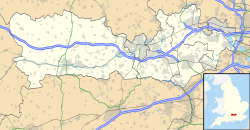| Hampstead Norreys | |
|---|---|
| Village and civil parish | |
 Church Road (part of the B4009) in the east | |
Location within Berkshire | |
| Area | 17.03 km2 (6.58 sq mi) |
| Population | 832 (2011 census) [1] |
| • Density | 49/km2 (130/sq mi) |
| OS grid reference | SU528763 |
| Civil parish |
|
| Unitary authority | |
| Ceremonial county | |
| Region | |
| Country | England |
| Sovereign state | United Kingdom |
| Post town | THATCHAM |
| Postcode district | RG18 |
| Dialling code | 01635 |
| Police | Thames Valley |
| Fire | Royal Berkshire |
| Ambulance | South Central |
| UK Parliament | |
Hampstead Norreys (alternatively spelt Hampstead Norris as it is pronounced) is a village and civil parish in Berkshire, England. It is centred on the River Pang, north of Newbury. As well as the nucleus of Hampstead Norreys, the parish includes the hamlets of Bothampstead, Eling and Wyld Court. The village was recorded in the Domesday Book of 1086 as Hanstede. [2]

